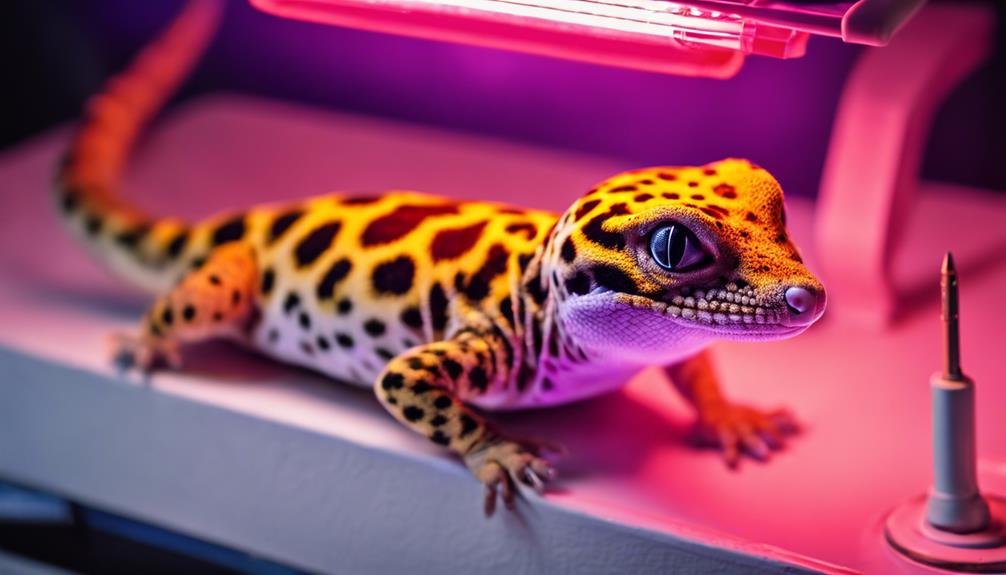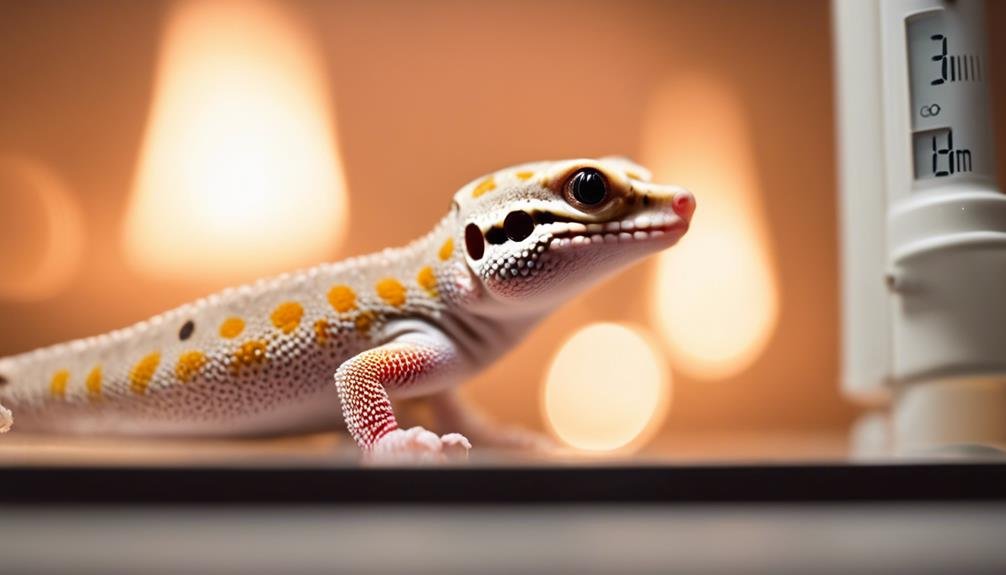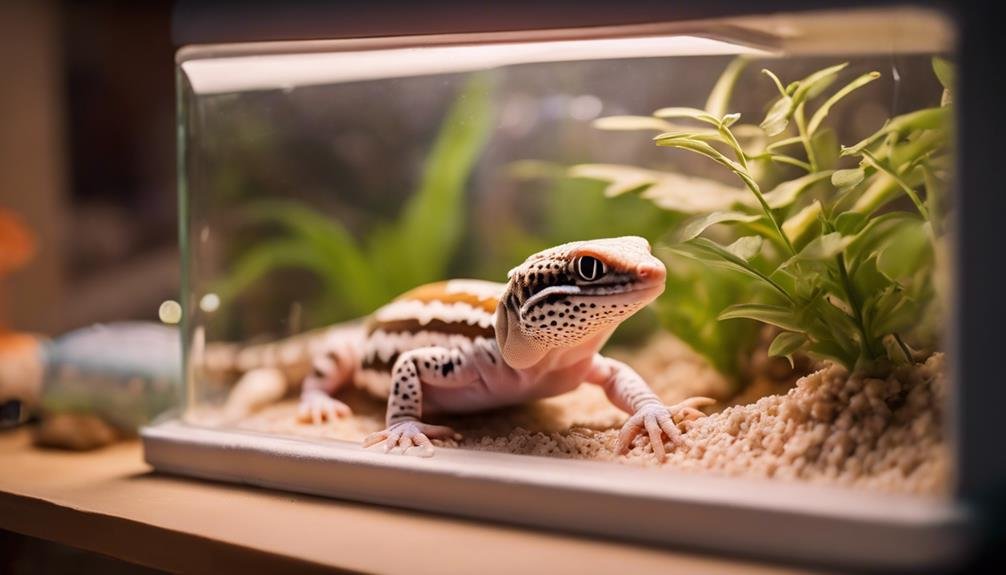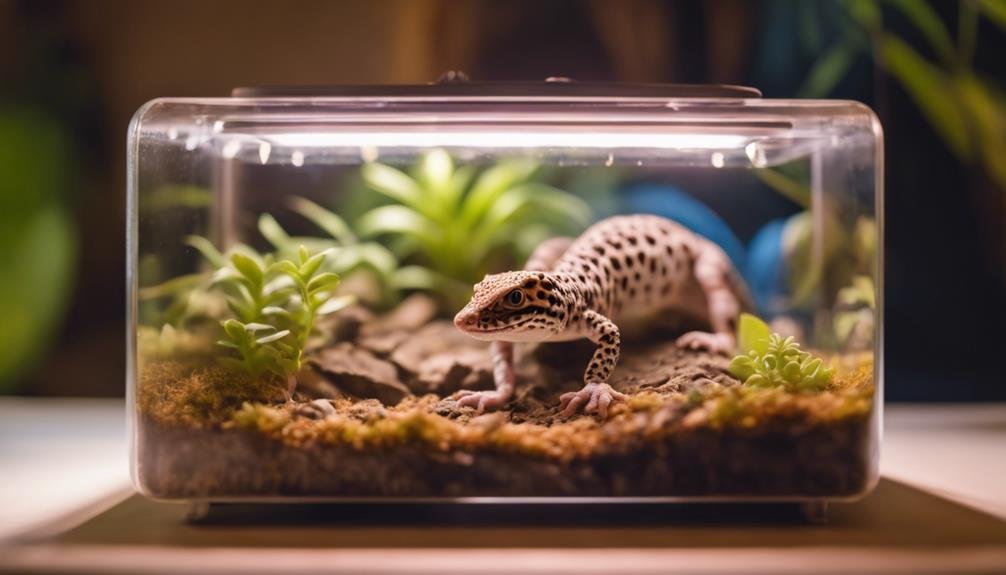If you're considering welcoming a leopard gecko into your home, you might wonder whether a heat lamp is a necessity for their enclosure. Proper temperature regulation is not just a matter of comfort for these reptiles; it's essential for their health and well-being. Without an adequate heat source, they're at risk of various health issues, from digestive problems to a weakened immune system. Additionally, maintaining the right temperature gradient can prevent unwanted brumation, ensuring your gecko remains active and healthy. But the question remains: is a heat lamp the best way to achieve this, or are there alternatives you should consider? Let's explore the intricacies of creating the ideal environment for your leopard gecko.
Key Takeaways
- Leopard geckos require a heat lamp to maintain a basking surface temperature of 94-97°F for optimal health.
- Inadequate heating from lack of a heat lamp can lead to sluggishness, loss of appetite, and digestive issues.
- Heat lamps help prevent brumation by providing consistent temperatures that mimic the gecko's natural environment.
- Proper temperature regulation with a heat lamp is crucial for digestion, metabolism, and preventing respiratory infections.
- Alternatives like under-tank heaters can complement heat lamps, but cannot fully replace the temperature gradient a lamp provides.
Leopard Gecko Heat Requirements
To ensure your leopard gecko thrives, it's important to maintain a basking surface temperature of 94-97°F, alongside a warm hide temperature of 90-92°F within their terrarium. These specific heat requirements are essential for your gecko's health, mimicking the warmth they'd experience in their natural habitat. Utilizing a thermostat-regulated heat mat can provide consistent belly heat, critical for their digestion and overall well-being.
Leopard geckos need a temperature gradient within their enclosure to regulate their body temperature effectively. This means setting up a cool end with temperatures ranging from 70-77°F, allowing your gecko to choose their preferred spot based on their current need for warmth. At night, you can let the temperatures drop to around 60°F to mimic the natural drop in temperature they'd experience in the wild. This nighttime temperature is crucial for simulating a natural environment, promoting healthy sleeping patterns and activity cycles.
Health Risks of Cold Exposure
While leopard geckos can thrive in warm environments, exposure to cold can greatly harm their health, leading to symptoms like sluggishness and loss of appetite. Cold exposure doesn't just make your gecko less active; it opens the door to a slew of health risks. Inadequate heating in their habitat leads to poor temperature regulation, which is crucial for their well-being. Without proper warmth, they struggle with digestive issues since they can't metabolize their food effectively.
Moreover, the chill doesn't stop at digestive problems. It also paves the way for respiratory infections and a weakened immune system. Leopard geckos exposed to low temperatures for prolonged periods find themselves fighting off illness more often, as their stressed immune system can't adequately protect them. This susceptibility to infections is a direct consequence of their environment being too cold.
Additionally, cold conditions can trigger brumation – a state of dormancy. While this might sound harmless, it's risky for geckos not in their peak health or those under a year old. It's crucial to make sure your leopard gecko's habitat is adequately warmed to fend off these health risks and keep your scaly friend thriving.
Benefits of Heat Lamps


You'll find that heat lamps are essential for creating an ideal environment in your leopard gecko's terrarium. They not only guarantee proper temperature regulation for your pet's health and comfort but also play a key role in mimicking their natural habitat, which is vital for their digestive health and activity.
Let's explore how these benefits can make a significant difference in your gecko's life.
Optimal Temperature Regulation
Heat lamps are important for leopard geckos, providing the necessary warmth that supports their digestion, metabolism, and overall health. By facilitating ideal temperature regulation, these devices play a key role in preventing a range of health issues, from digestive problems to respiratory infections and weakened immune systems.
They're essential for maintaining a natural day-night cycle, greatly reducing stress and promoting well-being in your pet. Additionally, deep core heating supports efficient thermoregulation, allowing leopard geckos to adjust their body temperature by moving across different zones within their habitat.
Using thermostats with heat lamps ensures precise temperature control, preventing the risk of overheating or harmful temperature fluctuations. This careful management is key to creating a safe, comfortable environment for your leopard gecko.
Enhanced Digestive Health
Properly used heat lamps greatly enhance your leopard gecko's digestive health by maintaining a consistent temperature gradient. These lamps are essential for regulating internal body functions, promoting efficient digestion, and supporting metabolic functions, which ensures ideal nutrient absorption. The consistent heat from these lamps aids in maintaining a healthy digestive system, marked by regular bowel movements, contributing to the overall well-being of your leopard gecko.
| Benefit | Impact on Leopard Geckos |
|---|---|
| Regulated Temperature | Promotes efficient digestion and metabolic functions. |
| Consistent Heat | Ensures ideal nutrient absorption and regular bowel movements. |
| Comfortable Environment | Maintains overall well-being and digestive health. |
Mimicking Natural Habitat
Often, heat lamps play a significant role in mimicking the natural basking environments that leopard geckos thrive in. By introducing heat lamps into their enclosure, you're not just providing a heat source; you're recreating the essential warmth found in their native habitat. This warmth is important for their digestion, metabolism, and overall health.
Additionally, heat lamps help establish a temperature gradient within the enclosure, allowing your leopard gecko to thermoregulate by moving between warmer and cooler areas. Proper placement of these lamps can ward off health issues, ensuring your gecko doesn't suffer from digestive problems due to inadequate heating.
Moreover, the right setup encourages natural behaviors and maintains ideal activity levels, making heat lamps indispensable for simulating the conditions of a leopard gecko's natural environment.
Choosing the Right Heat Lamp


Now that you're aware of the benefits heat lamps offer your leopard gecko, it's time to focus on selecting the right one.
You'll need to take into account the type of lamp and how it regulates temperature to provide a comfortable environment.
Let's look at the differences between heat lamp types and some temperature regulation tips to keep your gecko healthy and happy.
Heat Lamp Types
When selecting the appropriate heat lamp for your leopard gecko, it's important to take into account factors such as wattage, bulb type, and the ideal distance from the tank. Choosing between halogen or ceramic bulbs affects how you manage the basking area temperature, important for your pet's comfort and health.
The right wattage ensures the heat lamp provides adequate warmth without overheating, while maintaining proper distance prevents health risks associated with excessive heat. Integrating thermostats can help you regulate these temperatures precisely, avoiding brumation and ensuring your gecko experiences a natural day-night cycle.
It's crucial to select a heat lamp that promotes well-being by providing consistent, safe heating, mitigating potential health risks.
Temperature Regulation Tips
Selecting the right heat lamp with the appropriate wattage is crucial to maintain a basking area temperature of 94-97°F, ensuring your leopard gecko stays comfortable and healthy. When choosing a heat lamp, consider these factors for effective temperature regulation:
- Bulb Types: Halogen or ceramic bulbs offer efficient heating options for creating a thermally stable environment within the terrarium.
- Distance: Guarantee the correct distance between the heat lamp and the tank to avoid overheating or underheating, maintaining a comfortable environment.
- Thermostats: Utilize thermostats designed for heat lamps to accurately regulate temperatures and prevent temperature fluctuations.
Installation and Setup
To guarantee your leopard gecko enjoys ideal warmth, securely mount the heat lamp above the tank, focusing on creating a temperature gradient. Positioning the heat lamp at one end allows for a cooler area at the opposite end, ensuring your gecko can regulate its body temperature by moving between these zones. Utilize a ceramic heat emitter bulb for infrared heat without light, perfect for your pet's night-time needs. A reflector dome will direct and focus the heat onto the basking spot, making it the perfect warm area for your gecko to relax.
Regularly monitor the temperature under the heat lamp to maintain the best basking spot temperature. This ensures your leopard gecko's environment is always comfortable and safe.
| Item | Purpose | Note |
|---|---|---|
| Ceramic Heat Emitter | Emits infrared heat without light | Ideal for night-time |
| Reflector Dome | Directs and focuses heat | Essential for creating a basking spot |
| Temperature Gauge | Monitors temperature under the heat lamp | Ensures the best temperature is maintained |
This installation and setup guide will help you provide the best care for your leopard gecko, ensuring they thrive under your care.
Alternatives to Heat Lamps


While heat lamps are a popular choice for keeping leopard geckos warm, there are several effective alternatives you might consider. Exploring different heating methods can guarantee your pet enjoys a comfortable and healthful environment. Here's a look at some top options:
- Under-Tank Heaters and Heat Tapes: These provide a consistent heat source from below, mimicking the natural warmth geckos would find on a sunbaked surface. They're great for maintaining stable temperatures without the bright light that might disrupt your gecko's day-night cycle.
- Ceramic Heat Emitter Bulbs and Carbon Heat Projectors: Unlike traditional bulbs, these emit no light, only heat, making them perfect for creating a warm environment 24/7. They can be used with reflector domes to direct the heat more efficiently into the enclosure.
- Combining Heat Mats with Low-Level Basking Lights or Halogen Heat Lamps: This setup offers deep-penetrating warmth and stable temperatures, closely mimicking the natural heating patterns your leopard gecko would experience in the wild. The combination ensures your gecko has access to a warm basking spot as well as a cooler area to retreat to, promoting natural thermoregulation behaviors.
Choosing the right alternative depends on your specific setup and your gecko's needs, but with these options, you're well-equipped to create a cozy and healthful habitat.
Managing Power Outages
When a power outage strikes, it's important you have a plan to keep your leopard gecko warm and safe. Power outages can be unpredictable, leaving your pet in the cold if you're not prepared. To maintain warmth, consider alternative heat sources like hot water bottles or hand warmers wrapped in towels. These can provide a temporary source of heat to keep your gecko comfortable.
Additionally, using insulating materials such as blankets or towels around the enclosure can help retain heat, making sure the temperature stays within a safe range. It's vital to monitor the temperature closely during these times to prevent any health issues from arising due to cold stress.
However, avoid the temptation to use candles or open flames as heat sources, as they pose significant fire hazards to your gecko's enclosure. Instead, prepare a backup plan that includes battery-operated heating devices or generators. These can offer a more reliable and safe way to provide continuous warmth during prolonged power outages. By planning ahead and having the right tools at your disposal, you can make certain your leopard gecko stays warm and healthy, even in the absence of power.
Can Using a Heat Lamp Cause Problems for My Leopard Gecko’s Temperature Regulation?
Using a heat lamp to meet crested gecko heat requirements may cause issues with leopard gecko temperature regulation. The heat lamp could create hot spots, making it difficult for the leopard gecko to find a comfortable temperature. It’s important to provide a variety of heat sources to ensure proper temperature regulation for your leopard gecko.
Frequently Asked Questions
Do Leopard Geckos Need to Brumate?
Leopard geckos don't need to brumate, but it can mimic their natural cycles, triggering metabolic changes and energy conservation through temperature drops and light reduction. If you decide to let yours brumate, it's important to gradually adjust their environment, monitor their health, and tweak feeding while ensuring they're well-hydrated.
Can Leopard Geckos Survive Without Heat Lamp?
No, leopard geckos can't survive without a heat lamp. They lack natural thermoregulation and rely on temperature gradients in their habitat to manage their body heat. Without it, they can't digest properly or maintain their metabolic rates, leading to health concerns.
Cold stress affects their survival instincts, causing behavioral changes. A well-set-up environment with proper heating supports their health, preventing issues and ensuring environmental enrichment essential for their wellbeing.
Do Leopard Geckos Need a Heat Lamp and Mat?
Absolutely, you need both a heat lamp and mat for your leopard gecko. They're essential for creating temperature gradients and basking spots in their habitat, promoting proper thermal regulation.
While UVB lighting supports their health, night heating maintains consistent temperatures. Always consider humidity levels, substrate choices, and safety precautions to optimize their environment.
Together, these elements not only guarantee their well-being but also contribute to environmental enrichment, making your gecko's home as natural as possible.
Should I Keep My Leopard Geckos Heat Lamp on All the Time?
No, you shouldn't keep your leopard gecko's heat lamp on all the time. They need a day cycle with UVB for energy efficiency and night temperature drops for safety.
Too much light exposure disrupts sleep patterns. Use a thermostat to control ambient warmth, considering humidity effects. This mimics their natural environment, ensuring their well-being without constant heat.
Addressing concerns about energy, safety, and the UVB necessity for their health.
Conclusion
To summarize, you'll find that providing your leopard gecko with a heat lamp is crucial to their health and well-being. It not only prevents a host of health problems but also ensures they're active and digesting properly.
Choosing the right heat lamp and setting it up correctly can mimic their natural environment, promoting healthy behaviors. Even considering alternatives or preparing for power outages, it's clear that maintaining the right temperature is key to your gecko's happiness and longevity.



[…] Leopard geckos have specific heat requirements to thrive. While they can survive without a heat lamp, maintaining the proper temperature is crucial for their well-being. Inadequate heat can lead to health issues, so it’s essential to provide a suitable heat source, like a heat lamp, to meet their leopard gecko heat requirements. […]